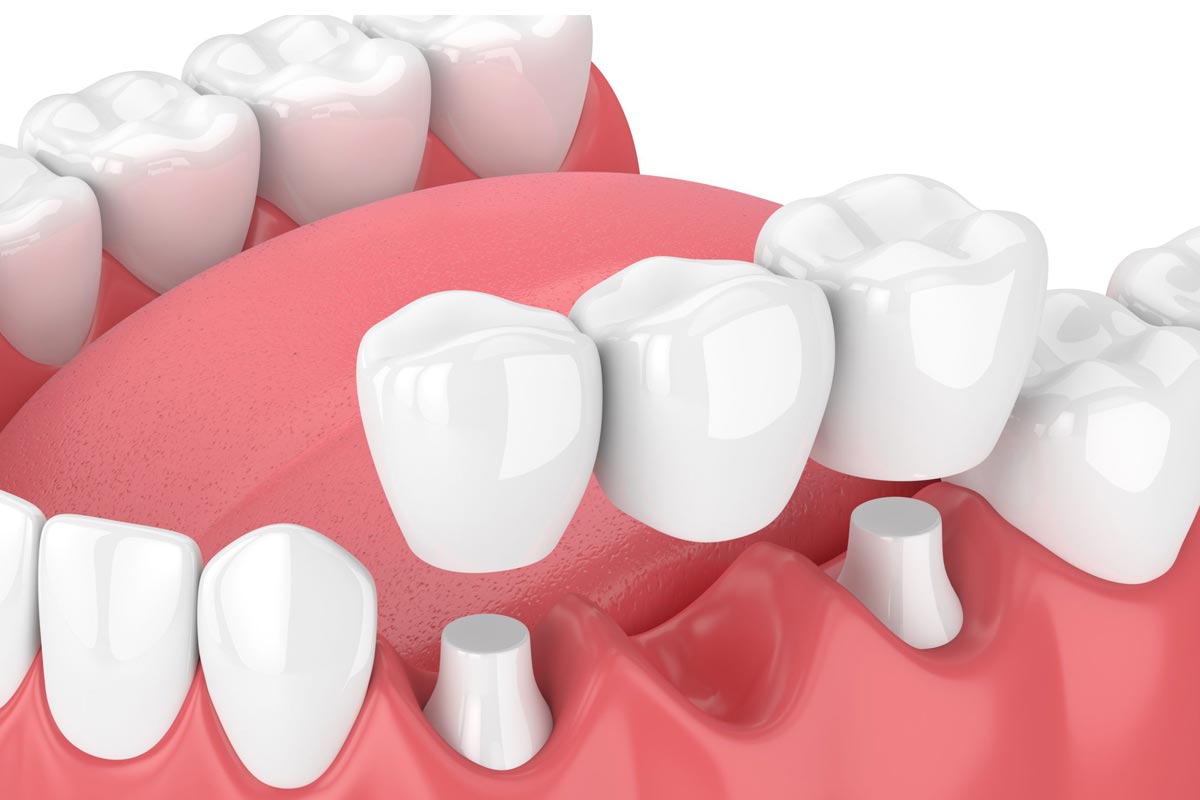dental crowns / dentures
CROWNS, IMPLANTS, BRIDGES & CO.
OUR PRICES:
- Single tooth implant with crown without any bone augmentation technology = from 3,000 CHF
- Titanium implants & ceramic implants = 1,000 CHF surcharge per piece.
DENTURES: WHEN IS IT NECESSARY?
Losing a tooth always means a gap in the teeth and therefore incorrect loading of the remaining teeth, which can ultimately affect the entire periodontium. If several teeth are affected, the food can no longer be chewed sufficiently and is reduced in size, so that even the diet can suffer as some vital substances can no longer be absorbed by the body due to the food being too large. The answer to the question about dentures is therefore simple: Lost and missing teeth should be replaced if possible! The only exceptions are wisdom teeth and teeth that, in rare individual cases, had to be removed by the dentist because the jaw was too narrow.
YOUR BENEFITS

Durable and secure

Painless treatment

individual solutions

Most modern materials

Fair pricing

Flexible scheduling

MATERIAL AND AESTHETICS
The choice of materials for Dental crowns ranges from metal alloys to full ceramics and zirconium oxide. Metal alloys are extremely durable, but do not offer an aesthetic solution. Full ceramics and zirconium oxide are visually appealing and offer an excellent fit, strength and durability. Full ceramics are not only very well tolerated (no known allergies), but also extremely stable and can be perfectly matched to the color of your own teeth. In addition, the very smooth surface of ceramics reduces the buildup of dental plaque and thus contributes to better oral hygiene. Ceramics also protect the tooth with its temperature-insulating properties.
CEREC FROM DENTANOVA
With the revolutionary CEREC method we can offer you the following services for dentures:
- Crowns on implants made of all-ceramic (e.max)
- Inlay/onlay/crown restorations made of plastic/plastic-ceramic hybrid or all-ceramic, depending on the respective indication
- Veneers and minimally invasive adhesive bridges for the highest aesthetic demands
- Dental bridges: Three- and multi-unit bridges (zirconium ceramic). From 4 links in collaboration with our dental laboratory specializing in Cerec. These are prepared, manufactured and inserted in two sessions, which is why temporary devices are necessary.
We also offer you high-quality implants, both classic and all-ceramic.


Frequently asked questions
When is an artificial dental crown necessary?
- The most common reason is tooth decay. Although enamel is the hardest material in our body, it cannot withstand repeated acid attacks. The acid is a byproduct of the breakdown of sugar by tooth decay-causing bacteria. Once the caries has penetrated the enamel, the bacteria no longer feed on the plaque, but on the organic tissue of the tooth bone (dentin). If this remains untreated, it is a self-perpetuating process that can lead to root inflammation. If the tooth decay is not treated in time by the dentist and the tooth is given a filling, it can completely hollow out the tooth. Even heavily and/or repeatedly filled teeth become weakened over time and need to be crowned.
- Accidents that severely damage teeth also require crowning.
- Individual problems such as severe teeth grinding, reflux (reflux of acidic stomach contents) or bulimia can massively attack tooth enamel over a long period of time. The natural tooth crowns are literally etched away and washed away, or in the case of teeth grinding, bitten away. The enamel sometimes disappears completely. The teeth are becoming smaller and smaller and functional disorders in the jaw joint can occur due to the lowered bite level. In these cases, an entire jaw renovation including reconstruction of the chewing plane using several partial or full crowns is necessary. However, modern adhesive technology now allows a minimally invasive approach. Only the missing parts of the teeth are replaced and secured with composites. In this case we speak of tabletops.
- Root treated teeth lose over time their strength and become brittle. A dental crown usually prevents the tooth from breaking.
- Lost or missing teeth create a gap that can be replaced with a bridge. This is attached to the artificial dental crowns of the adjacent teeth. Depending on the size of the tooth gap, implants can also be placed.
What material should my crown be made of?
Full ceramic (very good): Ceramic is not only well tolerated (no known allergies), but also extremely stable and can be perfectly matched to the color of your own teeth. In addition, the very smooth surface of ceramic reduces the accumulation of plaque and plaque, thereby contributing to better oral hygiene. Ceramic also protects the tooth through its temperature-insulating properties. A crown made of all-ceramic meets the highest demands and fits seamlessly into the existing teeth.
Metal (aesthetically obsolete): There are steel, titanium and gold crowns, with gold crowns certainly being the best-known representatives of metal crowns. Although the durability and compatibility of metal crowns speak for themselves, veneer crowns and ceramic crowns have overtaken them due to their appearance.
However, steel crowns are still used today in poorer countries due to their low cost. Titanium crowns are more expensive, difficult to fit, and gray-black in color. Gold crowns only enchant the viewer in very limited cultural or musical circles - no matter how beautiful the gums may look - and actually only make sense if you invest in rising gold prices and always want to keep the investment as close to your body as possible.
Veneering crowns made of different materials: In order to make aesthetically questionable metal crowns look like normal teeth, so-called veneer crowns were designed, the visible part of which is veneered with a tooth-colored material.
Veneer crowns are therefore made up of two different materials. The substructure is made of metal, which is then covered with a tooth-colored ceramic or plastic veneer. Not an easy task, but one that is usually no longer necessary since the advent of all-ceramic crowns.
Metal-ceramic crowns may be considered in special cases where the tooth boundary is very deep beneath the gums. In all other cases, aesthetics, biocompatibility and price clearly speak in favor of the all-ceramic crown.
What types of dentures are differentiated?
Dentures are basically divided into “fixed dentures” (crowns, partial crowns, bridges, implants), “removable dentures” (dentures and partial dentures) and “combined dentures” (combination of fixed and removable parts). The type of denture is determined, among other things, by the size of the gap.
What is the difference between a crown and a bridge?
While a crown covers a single tooth, a bridge replaces one or more missing teeth by attaching them to adjacent teeth.
What should I know about bridges?
Bridges usually last twenty to thirty years before they need to be replaced, provided the tooth structure underneath is undamaged by tooth decay and periodontitis. They have been tried and tested millions of times and can be more cost-effective compared to (multiple) implants. Thanks to stable frameworks, even several missing teeth can be bridged.
The disadvantage, however, is that the neighboring teeth are used for stabilization, which means that these adjacent teeth (also called abutment teeth) have to be ground down and crowned, even though they are otherwise probably healthy. Furthermore, the jawbone recedes at the point where the tooth gap was bridged because it is no longer subject to any load there due to the missing tooth.
However, if several teeth are missing, it makes sense to combine bridges with implants so that entire rows of up to twelve teeth can be replaced with just four or six implants. We are increasingly using zirconium as a material for large bridges: tooth-colored, metal-free and very stable.
When does a dental implant make sense?
An implant is usually the best choice in the case of individual gaps because it stands on its own and can be optimally cared for. The prerequisite for this is sufficient bone substance in the jaw. Implants are placed directly into the jawbone and can last a lifetime. They fit perfectly into the existing teeth and absorb the chewing load just like healthy teeth.
What do I need to know about removable dentures, i.e. dentures, full dentures and partial dentures?
Dental prosthetics, which takes its name from the word “prosthesis” (= replacement of a missing body part), is concerned with restoring the function of the chewing organ. Prostheses are used when there are no or not enough of your own teeth left to allow for a permanent restoration. Even though implantology today offers significantly more options for producing permanent dentures than before, the necessary conditions for this are not always present, for example if there is no longer enough jawbone.
Partial or full dentures have been around since time immemorial and generally work well. However, a full denture in the lower jaw is usually a shaky affair. Unlike the upper jaw, where the prosthesis is held in place by a suction effect, the lower jaw prosthesis rests on a thin ridge that gradually disappears over time. There is a remedy here through fixed prosthetics: With modern dentistry, it is often possible to firmly anchor the existing full dentures afterwards using implants.
What is a combined denture?
The combined denture consists of two parts: a fixed and a removable element. The fixed element is attached to a stable tooth or implant and serves to anchor the removable counterpart - the partial denture. Press studs or so-called locators serve as fastening elements: fastening elements whose counterpart (matrix) is embedded in the prosthesis.
A combined denture offers several advantages. On the one hand, the attachment to the remaining teeth or implants ensures a very good hold. Compared to unattached partial dentures, the teeth that are used for attachment are also better protected against tooth decay. On the other hand, overloading of individual teeth is avoided by blocking the remaining teeth. Furthermore, the costs are lower than if several teeth are completely replaced with implants.






